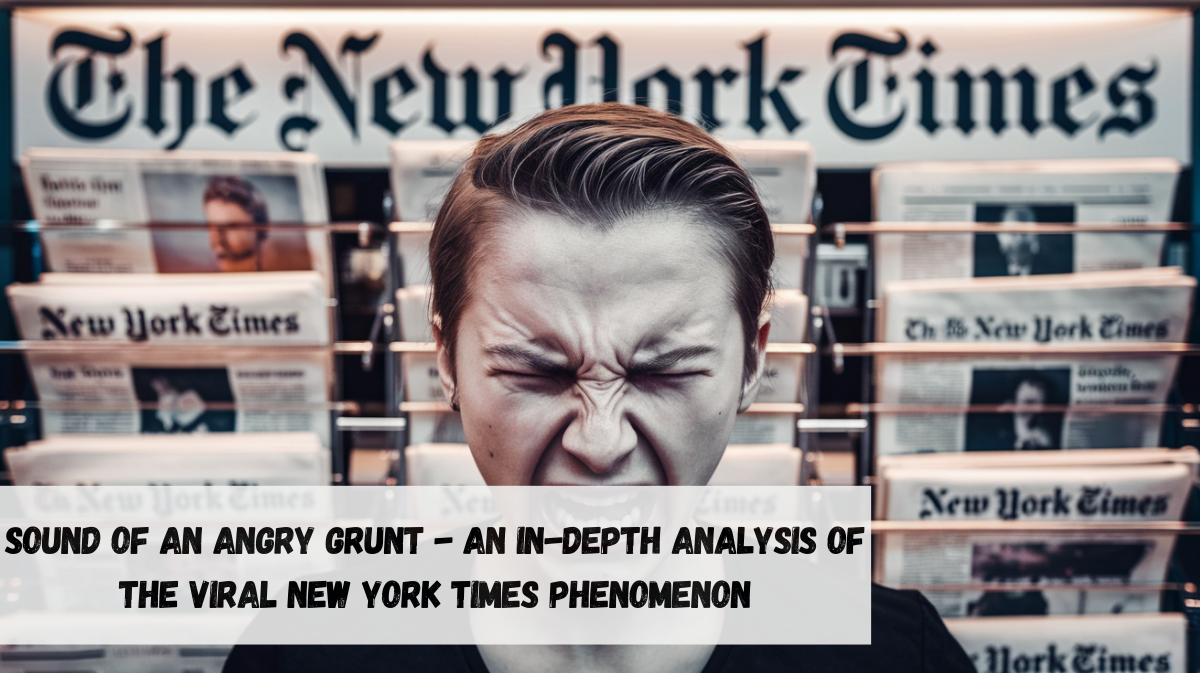Section 1: Introduction: The Emergence of the “Sound of an Angry Grunt”
Overview of the Phenomenon
The term “sound of an angry grunt” has recently become a significant cultural reference point, thanks to The New York Times and the broader media landscape. This phrase, simple yet evocative, taps into the universal experience of frustration and anger. It captures the visceral, often non-verbal expression of emotion that many people can relate to. The phrase has transcended its origins, becoming a shorthand for expressing a range of emotions in everyday conversations and online interactions.
The “sound of an angry grunt” from The New York Times is a cultural touchpoint reflecting human frustration, resonating widely due to its universal relatability and online virality.
Explanation of the Term’s Origin
The phrase “sound of an angry grunt” gained prominence after a specific article in The New York Times highlighted it, shedding light on how such expressions are not just guttural sounds but carry profound emotional weight. The article explored how these noises, though simple, resonate deeply with human experiences of anger and frustration, often serving as an outlet for emotions when words fail.
Cultural and Social Significance
The “sound of an angry grunt” is more than just a phrase; it has become a symbol of the shared human experience. It’s a reminder of how emotions are universally experienced and expressed, regardless of language or culture. This phenomenon highlights how something as primal as a grunt can become a focal point for discussions about emotion, communication, and media.
Section 2: The Origin Story: How “Sound of an Angry Grunt” Entered Popular Culture
Historical Context
Understanding the historical roots of non-verbal expressions of emotion is key to appreciating why the “sound of an angry grunt” became so prominent. Historically, grunts and similar sounds have been used in various cultures as expressions of frustration, anger, or even exertion. From the battlefield to the sports field, these sounds have long been associated with intense, raw emotions.
Role of The New York Times in Popularizing the Phrase
The New York Times played a pivotal role in catapulting the “sound of an angry grunt” into the spotlight. The article that brought this phrase to public attention explored the broader implications of non-verbal sounds in communication, particularly focusing on how these sounds are increasingly recognized as a significant part of human interaction. The Times’ coverage not only documented the phenomenon but also analyzed its broader social implications, contributing to its viral spread.
Examples of Its Initial Usage
The phrase was first used in specific contexts where traditional verbal communication broke down, and the grunt took center stage as a primary means of expression. This could range from sports events where players, in moments of high tension, emitted grunts, to public speeches where a moment of frustration led to a spontaneous, angry grunt. These instances were initially niche but quickly gained traction, especially once media outlets began to pick up on the trend.
Section 3: Why “Sound of an Angry Grunt” Resonate So Strongly?
Psychological Analysis of Anger and Frustration
Anger and frustration are emotions that everyone experiences, and they often manifest in physical ways, such as through grunts or other non-verbal sounds. Psychologically, these sounds are a release, a way for the body to expel built-up energy that words alone cannot convey. The “sound of an angry grunt” is a perfect example of this—an immediate, visceral response to a situation that triggers strong emotions.
Why Grunts Are an Instinctual Response
Grunts are among the most primal sounds humans can produce. They originate deep within our evolutionary past, where verbal communication was limited, and such sounds served as crucial signals to others. In moments of intense emotion, the brain reverts to these instinctual behaviors, making grunts a natural, almost automatic response to frustration and anger.
The Emotional Impact of Auditory Expressions
Auditory expressions like grunts can have a profound emotional impact, both on the person emitting the sound and those who hear it. For the individual, it’s a release of tension; for others, it’s a signal that something is wrong or that someone is upset. The “sound of an angry grunt” is particularly powerful because it cuts through the noise, conveying a clear and unmistakable message of displeasure.
Section 4: The Role of Media in Amplifying the “Angry Grunt”
How The New York Times Covered the Phenomenon
The New York Times article that brought attention to the “sound of an angry grunt” did more than just describe the phenomenon—it analyzed it in depth. The article explored how such non-verbal sounds are integral to human communication and how they have been historically underappreciated. By doing so, The Times not only informed its readers but also encouraged them to pay more attention to these subtle yet powerful expressions of emotion.
The Role of Social Media in Spreading the Concept
Social media played a crucial role in transforming the “sound of an angry grunt” from a niche topic into a viral sensation. Platforms like Twitter, Facebook, and Instagram allowed users to share their own experiences with angry grunts, often through humorous memes or relatable anecdotes. This digital amplification was key to the widespread recognition of the phrase.
Viral Moments: Memes, Videos, and Public Discourse
As the phrase gained traction, it quickly became fodder for memes and viral videos. These often humorous takes on the “sound of an angry grunt” resonated with a broad audience, further embedding the phrase into the cultural lexicon. Public discourse around the phrase expanded beyond just the sound itself, sparking conversations about the nature of anger, communication, and the ways in which we express emotions in the digital age.
Section 5: Linguistic Analysis: What Is in a “Grunt”?
The Anatomy of a Grunt: Sound Production and Linguistic Function
A grunt, at its core, is a short, guttural sound produced by a forceful exhalation of air. Linguistically, grunts function as non-verbal exclamations, often carrying significant emotional weight despite their simplicity. They can convey a range of emotions, from mild frustration to intense anger, depending on the context and the intensity of the sound.
How Grunts Are Used in Different Cultures and Languages
While the basic sound of a grunt is universal, its usage and interpretation can vary widely across different cultures and languages. In some cultures, grunts are a common part of everyday communication, used to express agreement, surprise, or disbelief. In others, they might be considered rude or impolite. Understanding these cultural nuances is essential to fully grasping the significance of the “sound of an angry grunt.”
The Symbolism Behind the Angry Grunt
The angry grunt is more than just a sound—it’s a symbol of the unfiltered expression of emotion. Unlike words, which can be carefully chosen and controlled, a grunt is raw and unmediated, making it a powerful representation of genuine human emotion. This symbolism has contributed to the phrase’s popularity, as it taps into a universal experience that transcends cultural and linguistic boundaries.
Section 6: The Psychological Underpinnings of Anger and Its Expression
Scientific Studies on the Link Between Sound and Emotion
Numerous scientific studies have explored the connection between sound and emotion, with a particular focus on how certain sounds, like grunts, can trigger specific emotional responses. These studies have found that sounds like grunts can evoke strong emotional reactions, both in the person making the sound and in those who hear it. This is because these sounds are closely linked to the brain’s emotional centers, making them a direct and powerful form of communication.
Theories on Why Humans Grunt When Angry
Several theories attempt to explain why humans grunt when angry. One theory suggests that grunts are a primitive form of communication, rooted in our evolutionary past. Another theory posits that grunts serve as a form of emotional release, allowing individuals to vent their frustration in a way that words cannot. Regardless of the exact reason, it is clear that grunts are an instinctual response to anger, reflecting the deep connection between emotion and sound.
The Role of Grunts in Non-Verbal Communication
Grunts are a key component of non-verbal communication, conveying emotions and intentions without the need for words. In many situations, a grunt can be more effective than a verbal response, as it communicates a raw, unfiltered emotion that is immediately understood by others. This makes grunts a powerful tool in human interaction, particularly in moments of intense emotion.
Section 7: Cultural Interpretations of the “Angry Grunt”
Examples of Grunts in Movies, Literature, and Music
Grunts have been used in various forms of media to convey emotion and add depth to characters. In movies, grunts are often used in action scenes or moments of high tension, where words are unnecessary or impossible. In literature, grunts can add a layer of realism to dialogue, while in music, they can be used to convey intensity or aggression. These examples highlight the versatility of grunts as a tool for emotional expression.
How Different Cultures Interpret and Express Grunts
Different cultures have their own interpretations and uses for grunts. In some cultures, grunts are a common part of everyday communication, used to express a wide range of emotions. In others, they may be reserved for specific situations or considered impolite. Understanding these cultural differences is key to fully appreciating the “sound of an angry grunt” and its significance in global communication.
The Intersection of Humor and Anger in Grunt-Related Content
One of the reasons the “sound of an angry grunt” has gained such popularity is its ability to straddle the line between humor and anger. In many cases, the sound of a grunt, while expressing genuine frustration, can also be humorous, particularly when exaggerated or taken out of context. This duality has made the angry grunt a popular subject for memes and viral content, as it resonates with both the serious and the comedic sides of human emotion.
Section 8: The “Angry Grunt” in Pop Culture: Memes and Media
Analysis of Viral Content: How Grunts Are Used in Memes
Memes have played a significant role in popularizing the “sound of an angry grunt.” These often humorous images or videos use grunts to convey a range of emotions, from frustration to exasperation. The simplicity of a grunt, combined with its powerful emotional impact, makes it an ideal subject for memes, which thrive on quick, relatable content that can be easily shared and understood.
The Evolution of the “Angry Grunt” in Pop Culture
The “angry grunt” has evolved from a simple expression of frustration into a pop culture phenomenon. It has been referenced in movies, TV shows, and even music, often as a way to convey a character’s emotional state in a way that is both relatable and impactful. This evolution reflects the broader trend of non-verbal communication becoming increasingly recognized as a significant part of human interaction.
Key Figures and Influencers Popularizing the Grunt
Several key figures and influencers have contributed to the popularity of the “angry grunt.” From celebrities who have used the grunt in public appearances to social media personalities who have made it a central part of their online personas, these individuals have helped bring the grunt into the mainstream, making it a widely recognized and understood symbol of frustration and anger.
Section 9: Case Studies: Iconic Moments of “Angry Grunts”
Famous Instances in Media and Real Life
There have been several iconic moments in both media and real life where the “sound of an angry grunt” has played a central role. These moments, often captured on video and shared widely, have become part of the cultural lexicon, serving as powerful examples of how grunts can convey deep emotion in a way that words cannot.
How Public Figures and Celebrities Have Used the Angry Grunt
Public figures and celebrities have also played a role in popularizing the “angry grunt.” Whether in interviews, public speeches, or social media posts, these individuals have used grunts to express their frustration in a way that resonates with their audiences. In some cases, these grunts have become signature moves, further cementing their place in pop culture.
Impact on Public Perception and Brand Association
The “sound of an angry grunt” has also had an impact on public perception and brand association. Companies and brands have begun to incorporate the grunt into their marketing campaigns, recognizing its power to convey emotion and connect with audiences. This has further expanded the reach of the phenomenon, making it a key part of modern communication and branding strategies.
Section 10: How to Manage and Channel Anger: Lessons from the “Angry Grunt”
Techniques to Manage Anger Effectively
While the “sound of an angry grunt” can be a natural and instinctual response to frustration, it is important to manage and channel anger in healthy ways. Techniques such as deep breathing, mindfulness, and physical exercise can help individuals control their anger and prevent it from escalating into more harmful behaviors.
Healthy Outlets for Frustration
In addition to managing anger, it is also important to find healthy outlets for frustration. Activities such as journaling, talking to a friend, or engaging in a creative hobby can provide a release for pent-up emotions, helping to prevent them from manifesting in harmful ways. The “angry grunt” can be one such outlet, providing a quick and simple way to vent frustration without causing harm to oneself or others.
How the Concept of the Angry Grunt Can Be Used in Anger Management
The concept of the “angry grunt” can also be used as a tool in anger management. By recognizing and acknowledging the grunt as a natural response to frustration, individuals can become more aware of their emotional state and take steps to manage it effectively. This can help prevent anger from escalating into more serious issues and promote healthier, more constructive ways of dealing with difficult emotions.
Section 11: The Future of the “Sound of an Angry Grunt”
Predictions on the Lasting Impact of This Phenomenon
As the “sound of an angry grunt” continues to gain popularity, it is likely to have a lasting impact on how we understand and express emotion. The phenomenon highlights the importance of non-verbal communication and could lead to a greater recognition of the role that sounds like grunts play in our emotional lives. In the future, we may see more emphasis on these forms of communication in both personal and professional settings.
How the Angry Grunt Might Evolve in Future Media
The “angry grunt” is also likely to evolve in future media, becoming a more prominent part of how emotions are portrayed in movies, TV shows, and other forms of entertainment. As non-verbal communication continues to gain recognition, the grunt may be used in new and creative ways, further cementing its place in pop culture.
Potential for Commercialization and Branding
Finally, there is potential for the “angry grunt” to be commercialized and used in branding and marketing campaigns. Companies could use the grunt to connect with audiences on an emotional level, using it as a way to convey frustration, determination, or resilience. This could open up new opportunities for creative marketing strategies that tap into the power of non-verbal communication.
Section 12: Frequently Asked Questions (FAQs)
What Does the “Sound of an Angry Grunt” Signify?
The “sound of an angry grunt” signifies a raw, unfiltered expression of frustration or anger. It is a non-verbal way of conveying intense emotion, often used when words are insufficient.
How Did The New York Times Contribute to the Popularity of the Angry Grunt?
The New York Times played a key role in popularizing the “sound of an angry grunt” by publishing an article that explored the phenomenon in depth, highlighting its significance in modern communication.
Why Do People Use Grunts to Express Anger?
People use grunts to express anger because grunts are a primal, instinctual response to frustration. They allow individuals to vent their emotions quickly and powerfully, without the need for words.
Conclusion
The “sound of an angry grunt” has emerged as a significant cultural phenomenon, resonating with people around the world due to its universal relatability. From its origins in The New York Times to its widespread use in pop culture and social media, the angry grunt has become a powerful symbol of human emotion. As we continue to explore the complexities of communication, both verbal and non-verbal, the “sound of an angry grunt” will likely remain a key part of how we understand and express our emotions.
This in-depth analysis not only sheds light on the origins and significance of the “sound of an angry grunt” but also provides practical insights into managing and channeling anger in healthy ways. As this phenomenon continues to evolve, it will undoubtedly continue to shape the way we think about and express our emotions, both online and offline.




